What Happened to Home Garage Arts?
Home car repair is a lost art. Repair used to go hand in hand with car ownership. The earliest car owners maintained their own vehicles. Chauffeurs were expected to have mechanic skills. Literature from the period stories of drivers getting under the hood so the passengers could continue their Whole generations of boys tinkered with cars in the 40s and 50s. As cars grew increasingly more complicated, and auto mechanics more specialized, drivers gradually stopped repairing their own cars. We must reclaim this lost art so we can experience more financial and civic freedom.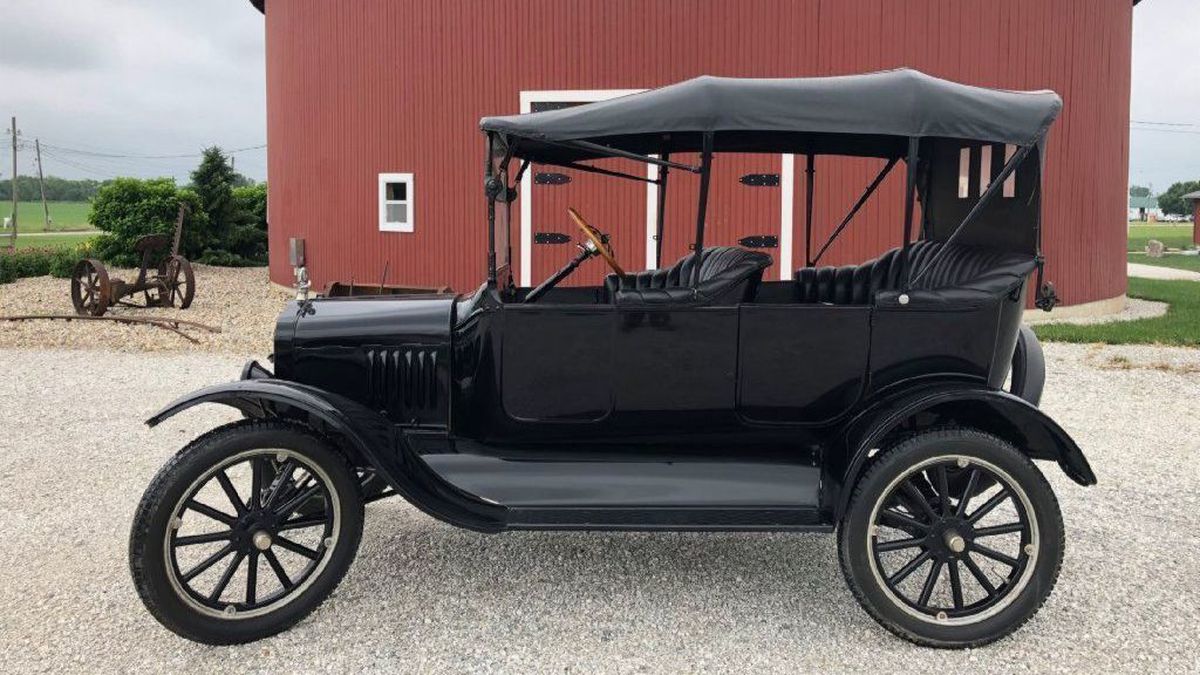
The Model T, from Ford was the first mass produced car.
A Brief History of Cars
Early cars were custom, expensive, more like toys. People who could drive them also learned to repair them. Early car repairmen were car whisperers–they tinkered with and maintained specific cars. This was important because every car was different. There were hundreds of car companies, selling a wide variety of custom cars. With so many different car companies, and so many different custom cars, how were car owners able to keep up with their own repairs? Why don’t more do so now when cars are standardized?The Beginning of Auto Repair
The first automakers were bike and carriage makers, metalworkers and machinists; there were over 100 car companies, which built gasoline, steam, and electric engines Electric engines appealed to women and the wealthy, steam engines were hard to start and appealed to the enthusiasts, and gas engines were easier to start than steam, and cheaper than electric engines. The gas engines eventually won out when Henry Ford began mass producing them.The Essence of Home Auto Repair
While researching for what happened to home auto repair, I came upon a site called Your Model T Stories. A family was featured: The Baulch family of Australia. The author’s grandfather had bought a model T in 1924. In 1967, he passed it to the author’s father. He immediately set to working on the car, first replacing the engine head. The car stayed on the family farm for 25 years, disassembled, and waiting for a full restoration that never happened. Ownership passed to the author in 1992. It was like a giant jigsaw puzzle with some missing pieces. After 10 months, the author figured out that there were 3 parts to the car: the chassis, the body, and the electrics, as he called it. After replacing pistons, and almost everything else, the car was running as good as new. The owner did all the engine work himself. Here is an illustration of the dying art of auto repair. Despite how simple the car was, it took 26 years to restore it. Most of that time was lost to procrastination.
A Timeline of the Baulch Family’s Model T Story
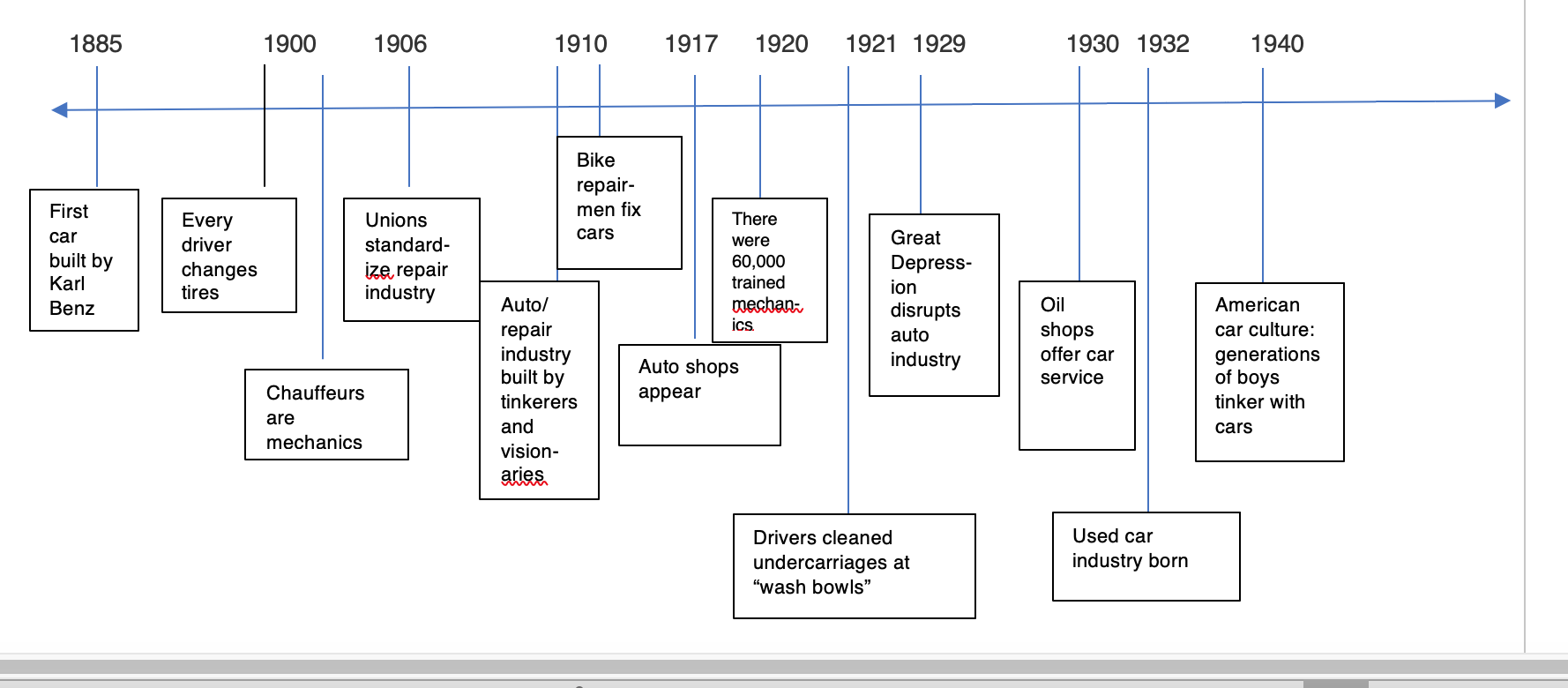
A Timeline of the History of Auto Repair
Cars through the 20th Century
The early 20th century brought standardization in the auto industry with Henry Ford, which also brought the price of the car way down. Assembly lines meant more mechanics at dealerships and private businesses, and competition arose between those two business models.
The Great Depression of the 1930s meant lower car sales, and car maintenance also took a hit. But, interestingly, car owners took responsibility for painting their own cars. Even cars straight off assembly line were poorly painted, so why wouldn’t the owners hand paint them–with brushes, no less?
By the Mid-20th century, the auto repair and auto-making industries had split in two, never to reconnect again. Car owners used to repair their own cars. Early cars were unstable, experimental, and expensive, yet car owners weren’t afraid to repair their own cars. Now it is a lost art. Car repair became a lost art because of professionalism, specialization, and secret information.
The Professionalism of the Garage Arts
When Henry Ford invented the Model T, he put cars into the hands of regular Americans. He innovated in the industry with the speed he was able to produce cars, which in turn brought the price down. Lower prices meant more cars sold, period.
With the car in more people’s hands came the demand for more auto mechanics. This led to unions, who worked to professionalize the mechanic trade. Car ownership gradually went from a driver’s personal responsibility to keep his car running to a responsibility to employ mechanics. Soon it became part of car ownership to patronize the dealer’s mechanic shop.
Home Auto Repair During the Depression
By the Great Depression, car purchases plummeted, and mechanic services sky-rocketed, as money was scarce, and maintaining possessions took priority. NAPA, the (National Auto Parts Association) showed up during this time period, in 1925. Advance Auto Parts was next, in 1935. The used car market also appeared during the Great Depression, in 1932. These developments during the car’s history really affected the auto repair industry.
Tool stores preceded the Auto parts stores. Lowes, a hardware store that sold diverse goods, like a general store, came first in 1921. Ace, a co-op of Chicago area tool stores was right on its heels, in 1924. The hardware store industry exploded during the post WWII era, as the DIY industray, particularly in the home improvement arena took off. The home improvement movement parallels the rise and fall of the amateur/home mechanic. What else happened to remove the garage arts from the home?
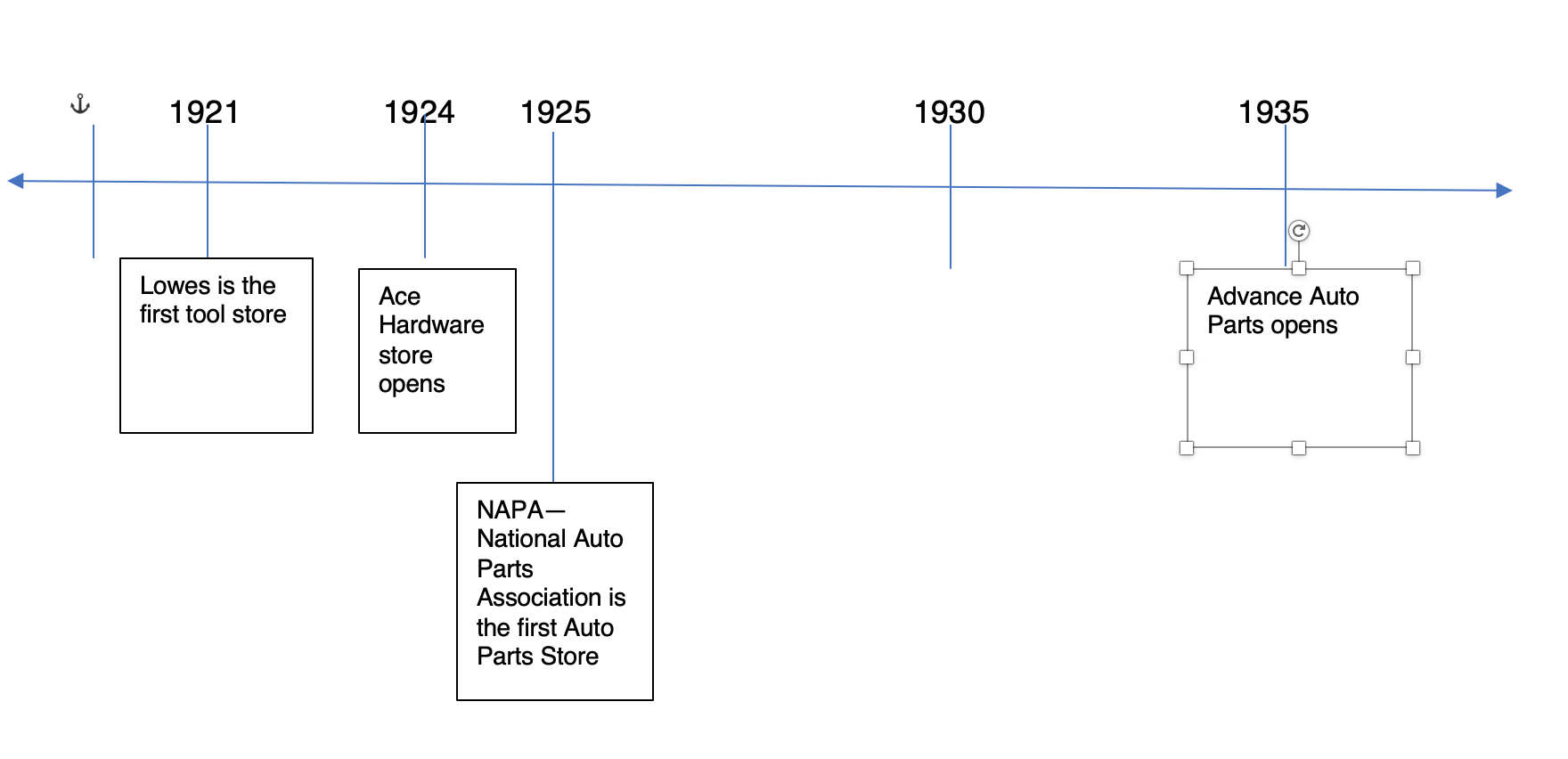
A timeline of the earliest tool and auto part stores
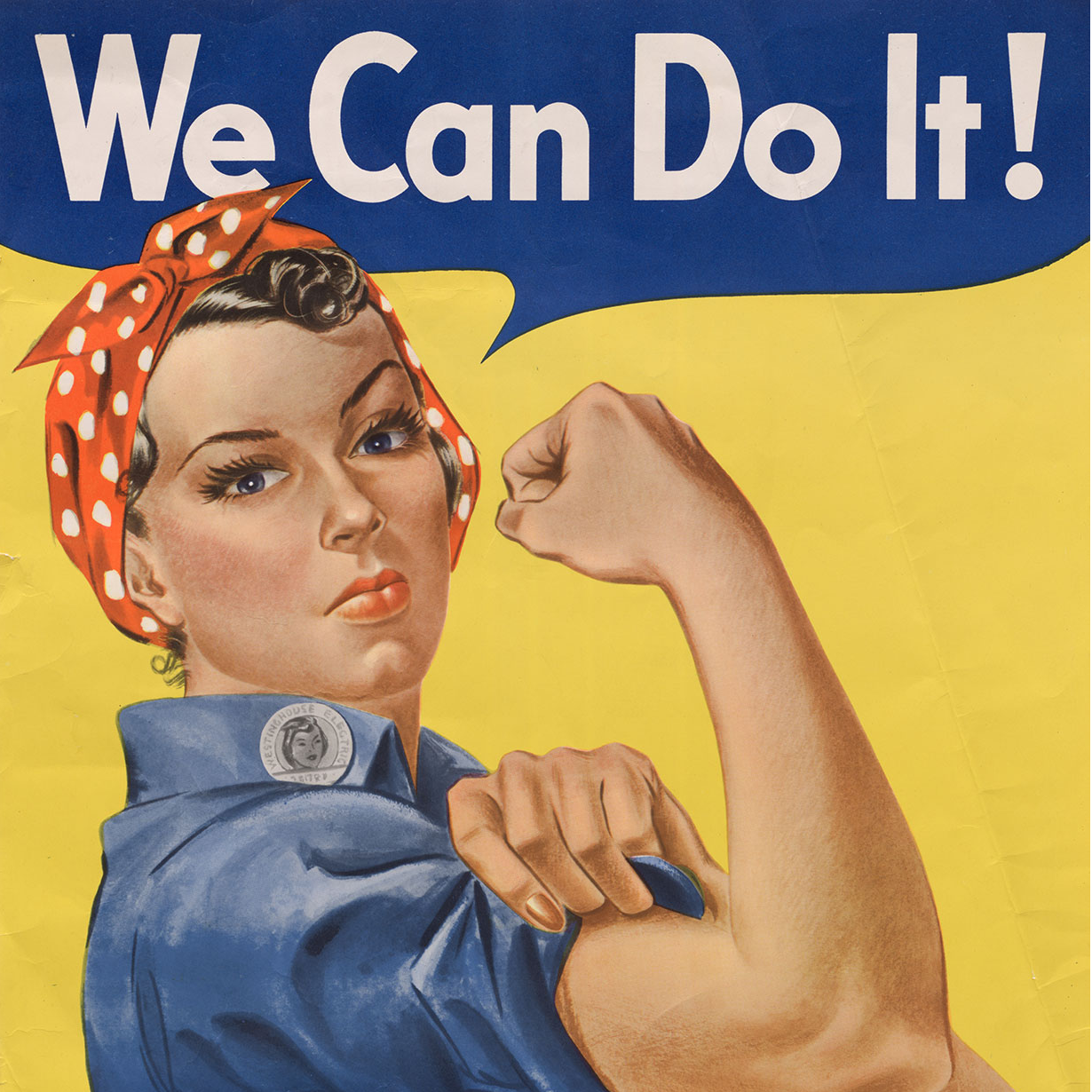
World War II Played a Huge Part
As the auto repair industry grew, so did specialization. As cars became increasingly complex in the 40s, mechanics needed more training in order to maintain them. Car owners were unable to keep up with their own repairs because of the war.
Most men were fighting in the war. Women were recruited to work in factories to support the war. Women weren’t repairing cars at home, and if their men were fighting the war, of course women would patronize mechanic shops.
Rationing
Rubber and gas were rationed because Japan had taken over our rubber distributors. Even though gas was rationed, that was because of the rubber shortage. Less gas meant fewer cars on the road, and fewer tires worn out. People were urged, through propaganda, to walk and take public transportation. People were only allowed 5 tires(4 + a spare) per car, and if they had any extra tires, they had to donate them to the war effort.
Another major WWII change to the automobile industry was this:
Automakers completely shut down making cars during the war, and were the chief suppliers of army vehicles, including planes! Cadillac’s famous V-8 engine found its way into the engine bays of a whole range of fighting vehicles.
But What About Civilian Cars?
In order to maintain cars in America, one major GM plant, at Saginaw, Michigan, was dedicated solely to producing replacement parts, so the nation’s existing fleet of GM vehicles could be kept running. The other car companies did similarly.
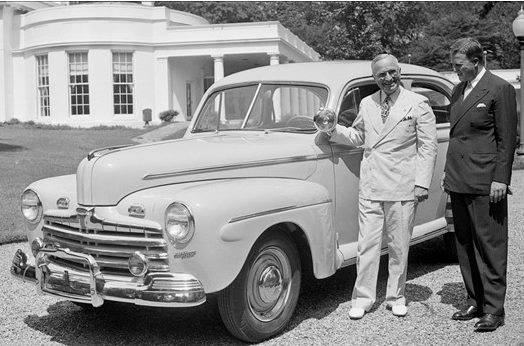
Post WWII America’s Love of Cars Grows
After the war, rationing ceased, and automakers returned to making cars. Henry Ford supercharged his company by presenting his first new car to President Harry Truman in 1946. Truman was a real car enthusiast, happily driving all over the country.
The 1950s were the genesis of American car culture. It was even depicted in TV shows and movies, like Happy Days, a TV show from the 1970s and ’80s. Grease was a movie based on a play about 1950s car culture.
Auto Repair Industry
Mass car production fed the auto repair shop industry. Auto repair started as the pragmatic exercise of keeping your own car running. It became a professional opportunity for advancement– the auto repair industry. Auto makers and mechanics themselves began to protect their industries from competitors. Chief among those competitors was the home auto mechanic.
The protections have gone so far as to create certifications and laws to prevent amateurs from taking care of their own auto problems. This has come to a head with the right to repair legislation in several states.
Specialization
Mechanics specialize in many separate areas, including engines, transmissions, electrical circuits, and diagnostics. That’s not to mention the specialties involved in body work.
One of the reasons opponents of right-to-repair give for locking out car owners from repairing their own cars is safety. So why can’t car owners learn to repair their cars the hard way? Professionals make mistakes, so why can’t car owners? That’s the way it is when you learn.
Expertise is also a poor excuse to lock people out. If people want the expertise of a mechanic, they are free to hire one. But if they want to do it themselves, they should have the freedom to do that.
Telematics: Secret Information
I mentioned before that more advanced car tech made it hard for car owners to keep up with repairing their own vehicles. One of the reasons for that was how car makers kept information secret, forcing everyone to patronize their auto shops. Telematics is an example of ‘secret information’ which prevents car owners from fixing their own cars. Until Massachusetts’s Right to Repair forced automakers to share telematics with car owners, they only shared this vital info with dealerships. With the passage of Right to Repair, we may see a resurgence of home auto repair. There shouldn’t be competition between the professional mechanic industry and car owners who want to keep their cars maintained themselves. Those who repair their own cars are not trying to put mechanics out of business; they are trying to save money and improve their skills.
Two Kinds of Freedom
We must reclaim the lost art of home auto repair, if we are to be truly free. There are two types of freedom we can gain by reclaiming the garage arts: financial and physical.
We Have a Plan That Works
We have taken a step towards physical and financial freedom by replacing our SUV engine in our own garage. If you can change your oil, you can learn to swap your engine. We can help with your engine swap. Control the time frame of your engine swap. Save money by doing it yourself. Start with the free engine replacement checklist, and the engine swap tool list. Finish with our fully indexed video course, which will guide you through the swap step by step.
Physical Freedom
What do I mean by physical freedom? The freedom to go where you want, repair how you want, drive what you want is what I mean by physical freedom. But we are limited in these decisions by how much money we have.
Financial Freedom
Financial freedom would fund that physical freedom. Just as Americans were able to save their resources for the WWII fighting effort, we should be able to save our financial resources by repairing our own vehicles in our own garages. Benjamin Franklin famously said, “A penny saved is a penny earned.” Repairing your own vehicle is a penny earned, indeed.
